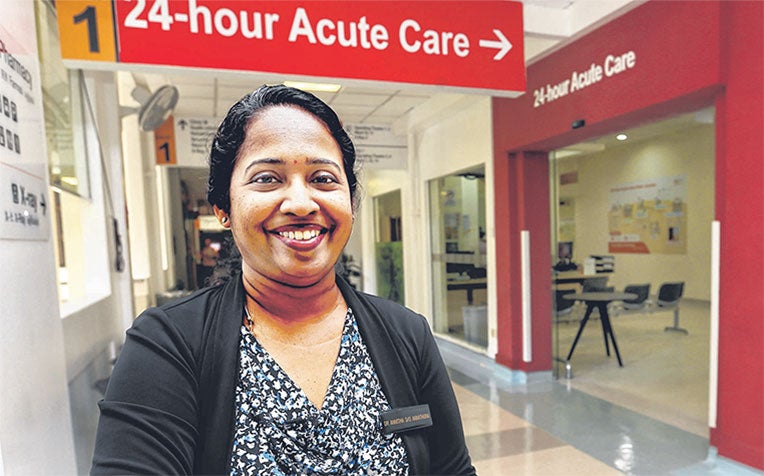
which closed for renovations, is open and has 24-hour acute care clinic.
Other public hospitals struggle with overcrowded emergency departments, but Alexandra Hospital has the opposite problem.
Its 24-hour acute care clinic, which is equipped to handle all but the most specialised emergencies, sees fewer than two patients an hour – although it is built to handle around 100 patients a day.
The reason, said Dr Annitha Annathurai, who heads its emergency medicine department, is that few people know that the hospital is open for business.
Closed in June 2015 for renovations, Alexandra began opening in phases from August that year. Its 24-hour acute care clinic opened last April with little fanfare. “A lot of people are not aware that Alexandra Hospital is still functioning,” said Dr Annitha. “Actually, there’s still an important facility here.”
The hospital is now being run by a team from Sengkang Health, although they will move to Sengkang General Hospital next year when the new building is ready. Alexandra Hospital will then be handed over to the National University Health System.
The 24-hour acute care clinic can handle ailments often seen at full-fledged accident and emergency (A&E) departments, such as cuts, fractures and infections.
However, it does not receive Singapore Civil Defence Force emergency ambulances. It also does not admit those with severe medical conditions – such as heart attacks – or those who need specialised care, such as burn victims or children. But such patients will not be turned away.
Dr Annitha said: “Usually, we assess the situation, stabilise the patient, and then transfer them to another hospital.”
Alexandra’s low patient load means that wait times can be remarkably short. Public hospital A&E departments typically treat upwards of 300 patients daily, but Alexandra’s clinic sees only 30.
Patients at the acute care clinic typically get to consult a doctor within 30 minutes, while the median waiting time for admission to a ward is less than 1 1/2 hours. In comparison, said Dr Annitha, the wait is around an hour for a doctor’s consultation at most other hospitals.
At the other six public general hospitals, the median waiting time for admission to a ward generally fluctuated between one and three hours last week. It spiked to more than four hours at Tan Tock Seng Hospital on two days, according to Health Ministry statistics.
Mr Shajahan Maideen, who went to Alexandra’s acute care clinic last Saturday for a leg infection, is still warded there. “I was at the hospital 10 to 15 years ago, so I made the decision to go to the acute care clinic,” said the 50-year-old senior boarding officer, who waited around 1 1/2 hours for a bed. “The service was fast and efficient.”
Dr Annitha said that some patients go to the clinic because they cannot find a general practitioner who is open late at night.
“We can start them on intravenous fluids and monitor them, for example,” she said. “We allow for all of this under one roof, which is not available in the GP setting.”
Contributed by














 Get it on Google Play
Get it on Google Play